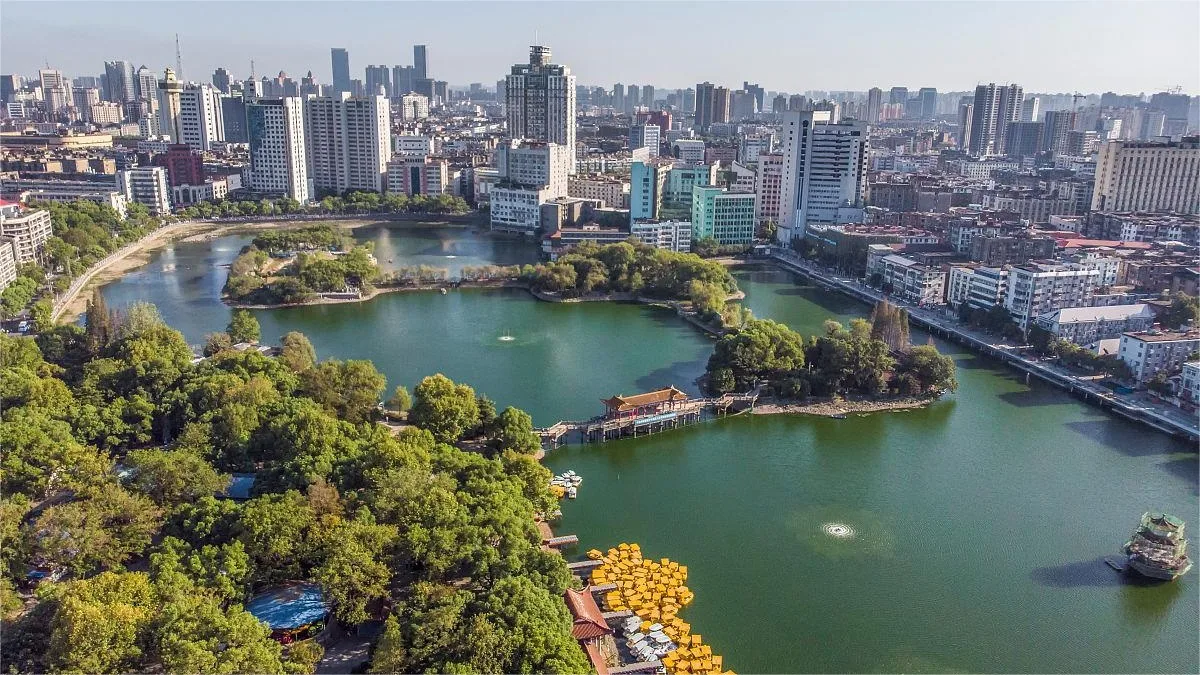Bayi Park (八一公园, 1st August Park), located at the heart of Nanchang City, spans a total area of 23.7 hectares, including 6.4 hectares of lush land. It is renowned for its abundant greenery, vibrant flowers, and particularly for its famed Baihua Island.
The park’s history dates back to the Tang Dynasty. In 802 AD, during the reign of Emperor Xianzong, a local official named Wei Dan initiated a project to control the flooding of Donghu (East Lake), which included dredging and planting willows. This led to the creation of Wanliu Dike and Huangjin Dike, transforming Donghu into a scenic lake. Over time, Donghu was divided into three parts: East, West, and North Lakes. During the Republic of China era, the lakes were further modified, and today, the lakes are interconnected with bridges and are collectively known as Donghu.
In the Southern Song Dynasty, a military official named Zhang Cheng built the Jianwu Pavilion on the southern island of Donghu to train naval forces. During the Qianlong period of the Qing Dynasty (1746), Governor Peng Jiaping inscribed the words “Baihua Island” on a large stone, which was later restored in 1983 along with the construction of a stone pavilion.
In the Qing Dynasty, the park served as a Confucian temple. It was converted into Houbin Park in 1932 and renamed Jieshi Park in April 1946. In July 1950, it was officially named Bayi Park. The park is divided into two main areas: the lake area and the land area.
Lake Area:
- East Lake: The primary body of water in the park, offering serene views and a peaceful ambiance.
- Baihua Island: The most famous part of the park, known for its blooming flowers and lush greenery.
- Baihua Bridge: A picturesque bridge connecting Baihua Island with other parts of the park.
- Guanao Pavilion: A charming pavilion providing panoramic views of the lake.
- Su Causeway: A scenic pathway that stretches across the lake, reminiscent of the famous Su Causeway in Hangzhou.
- Shuimuqing: A tranquil spot known for its clear waters and reflection of the surrounding trees and pavilions.
- Huaguan: A beautiful pavilion that serves as a popular spot for visitors to relax and enjoy the scenery.
- Nine-Curve Bridge and Lakeside Pavilion: Offering picturesque views and an ideal spot for photography.
- Boatyard Pier: Where visitors can rent boats to explore the lake.
Land Area:
- Cultural Lawn Plaza: Features over ten stone statues of historical figures from various Chinese dynasties, including Jin, Tang, Song, Yuan, Ming, and Qing.
- Tea House: A place where visitors can enjoy traditional Chinese tea.
- Children’s Playground: An area designed for children to play and have fun.
- Greenhouse: Houses a variety of plants and flowers, providing a delightful experience for botanical enthusiasts.
Despite being located in the busy city center, Bayi Park offers a peaceful retreat with its lush greenery and tranquil waters. It attracts a steady stream of visitors daily, who come to enjoy the natural beauty and serenity of the park. Additionally, the park hosts large-scale flower and lantern exhibitions annually, drawing even more visitors.
Basic Information
| Estimated Length of Tour | 1 hour |
| Ticket Price | Free |
| Opening Hours | 24 hours a day throughout the year |
| Telephone Number | 0086-0791-86299621 0086-0791-86299631 |
Location and Transportation
Bayi Park is located at 106 Min De Road, Donghu District, Nanchang City, Jiangxi Province. To get there, you can choose one of the following ways:
Bus: Take bus 17, 212, or 230 and get off at Bayi Park East Gate Stop (八一公园东门站). Take bus 205 and get off at Bayi Park Stop (八一公园站). Or take bus 25, 205, or 830 and get off at Baihuazhou Stop (百花洲站).
Metro: The closest metro station to the park is Bayi Hall (八一馆) on line 1 and line 3. After getting out of the station from Eixt 1, walk about 400 meters to the east to reach the park.








